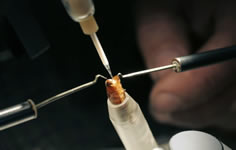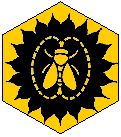Drone Rearing

Drone rearing is just as important as queen rearing. Though drones are usually considered worthless, to me the right drones are worth their weight in gold. In fact the whole system revolves around the availability of drones. Queens can be raised almost anytime, but the colonies must still be willing to produce drones. This is often the limiting factor in the early spring and fall queen production.
Because we are located in an area with feral Africanized colonies, we have to be absolutely certain that the drones are from the desired queen. Drones are notorious drifters and once  they are allowed to fly you can never be sure they belong to the colony they are found in.
they are allowed to fly you can never be sure they belong to the colony they are found in.
This problem is avoided by hatching out drones above a  queen excluder, and keeping them confined for about 2
queen excluder, and keeping them confined for about 2  weeks. Frames of drone brood from various queens of the same type are hatched together, so a drone bank like this acts as an artificial drone congregation area. When they are sexually mature they will be attracted to light. By keeping a plastic sheet under the lid, the drones can be captured as they try to fly toward the light. They are gathered and kept in a flight cage along with some comb with open honey. They can be kept here for a few hours until they are used. A box of drones like this takes about 3 hours to extract enough semen to inseminate 20 queens.
weeks. Frames of drone brood from various queens of the same type are hatched together, so a drone bank like this acts as an artificial drone congregation area. When they are sexually mature they will be attracted to light. By keeping a plastic sheet under the lid, the drones can be captured as they try to fly toward the light. They are gathered and kept in a flight cage along with some comb with open honey. They can be kept here for a few hours until they are used. A box of drones like this takes about 3 hours to extract enough semen to inseminate 20 queens.
Drawing by Dr. Peter Schley


From "Anatomy of the Honey Bee" by R.E. Snodgrass


The penis of a drone is a lot like a Swiss army knife with a lot of attachments. The function of all of it’s complex structures are not completely known. The organ is like a balloon, which is folded up inside him until the moment of mating. The drone mounts the queen from behind and in an explosive instant his body goes into a fatal contraction which forces air and fluid to inflate the penis. He falls backwards, breaking off the penis which is left in the queen, known as the mating sign. He falls to the ground to a glorious death.
We can trigger the same contraction of the drone with the right pressure on the thorax and abdomen. It’s a skill anyone can learn by practicing on a few hundred drones. Popping the drones is the first step in the instrumental insemination process. Notice that there are two fluids on the tip of the endophallus, the semen is tan colored and the bright white is mucus. The trick is to separate the two.
Semen Collection
 Collecting the semen is the most delicate and time consuming part of the entire process. The tan semen must be drawn off from the white mucus which will clog the tip of the syringe and cause much trouble and waste of time. By expelling a little semen from the tip and allowing it to make contact with the semen to be collected, it will adhere and allow it to be drawn up without mucus or air bubbles. A capillary tube is filled with semen from about 200 drones and allowed to mix naturally for 24 hrs. By allowing it to mix, every queen inseminated will contain sperm from far more drones than a naturally mated queen would. This additional genetic diversity helps avoid inbreeding when a queen breeder uses this queen to graft daughters from.
Collecting the semen is the most delicate and time consuming part of the entire process. The tan semen must be drawn off from the white mucus which will clog the tip of the syringe and cause much trouble and waste of time. By expelling a little semen from the tip and allowing it to make contact with the semen to be collected, it will adhere and allow it to be drawn up without mucus or air bubbles. A capillary tube is filled with semen from about 200 drones and allowed to mix naturally for 24 hrs. By allowing it to mix, every queen inseminated will contain sperm from far more drones than a naturally mated queen would. This additional genetic diversity helps avoid inbreeding when a queen breeder uses this queen to graft daughters from.

My insemination setup is pretty simple, and it all fits on one tabletop. I use a Schley insemination device that works beautifully. The Harbo syringe makes collecting a large amount of semen to inseminate 20 queens at a time easy. The microscope magnifies just 10 times, and the light is a very bright but cool fiber optic.
A balance is used to weigh each queen just before insemination, small queens below 150 mg are eliminated. Also each queen is inspected for imperfections such as lost legs and antennas or discolored footpads which are important for pheromone production. It doesn’t make sense to invest the time to inseminate any imperfect queens, as they are likely to be quickly superceded.The computer is the tool that makes keeping track of each queen’s pedigree and performance practical and easy. The insemination technology is over 50 years old, but it’s really the application of new information technologies that opens up powerful new ways of looking at bees.
Insemination of virgin queens
 The actual insemination process is quick and easy.
The actual insemination process is quick and easy.
Queens are put to sleep with CO2.
Under a low power microscope the queen is positioned in the insemination device.
The stinger is gently pulled out of the way and the syringe inserted.
8 micro liters of semen injected into the oviducts and the sperm will migrate to the spermatheca.
With a little practice it’s a very reliable process, with nearly all queens successfully inseminated.

Marking the queen with a numbered plastic tag gives her a positive identification number which is recorded on a spreadsheet program with all her pedigree data. Half a forewing is clipped to keep her from ever flying to mate and as a backup id if the tag should fall off. 
A color coded thumbtack is also used as a working record that will follow the queen on her cage or hive where ever she goes.The queen is kept in the bank for another week. A second CO2 treatment done on all the queens at once in th e bank frame.
e bank frame.

Next Page: Queen Introduction
From a talk presented by Tom Glenn at Apimondia in Melbourne Australia, Sept. 2007

About Us | Site Map | |
This page is no longer being updated.
 Glenn Apiaries
Glenn Apiaries